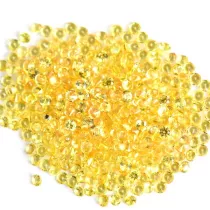Naturlig citrin er en gennemsigtig variant af kvartsmineralet kendt for sine nuancer af gul til lysebrun. Denne karakteristiske farve skyldes tilstedeværelsen af jernurenheder (Fe³⁺) i dens krystalstruktur. Citrin dannes i det trigonale krystalsystem og har en hårdhed på 7 på Mohs skalaen, hvilket gør den relativt holdbar og velegnet til brug i smykker.
Geologisk findes citrin ofte i pegmatitter og hydrotermiske åbninger, hvor krystallerne dannes i hulrum. Det er sjældent i naturen, og mange af de sten, der sælges som citrin, er faktisk ametyster eller røgkvarts varmebehandlet for at opnå den ønskede farve.
Fysiske egenskaber af citrin omfatter glasagtig glans, conchoidal fraktur og fravær af spaltning. Dens massefylde er cirka 2,65 g/cm³ og dens brydningsindeks varierer mellem 1,544 og 1,553. På grund af sin gennemsigtighed og glans er citrin højt værdsat i gemologi og smykker.
Citrin er ofte forbundet med metafysiske egenskaber, der betragtes som en sten af velstand og overflod. I alternativ praksis siges citrin at stimulere kreativitet og mental klarhed, selvom disse aspekter ikke understøttes af videnskabelige beviser.












